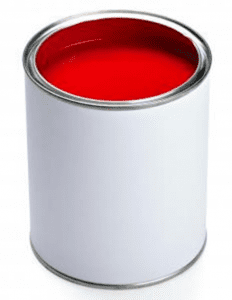The third in a series of articles with practical advice for quantifying customer value.
Having worked closely with several B2B product teams quantifying customer value, I can state confidently that most product managers don’t know jack about units of measure. If you truly want to know how much customer value your products generate for your customers, then you need to appreciate the difference between pricing units and customer units of measure.
Painting a Picture of the Situation
 The best way to illustrate this is with a simple example. Let’s say your product is red paint. You sell your red paint to your customers in one-gallon paint cans. This is the pricing unit of measure as in: price of paint = $20 per gallon can.
The best way to illustrate this is with a simple example. Let’s say your product is red paint. You sell your red paint to your customers in one-gallon paint cans. This is the pricing unit of measure as in: price of paint = $20 per gallon can.
Suppose your red paint is highly differentiated, meaning it provides performance characteristics superior to all other comparable paints. How do you quantify that unique customer value? For instance, would you say that your paint provides $5 worth of value per can, because your price is $5 higher than other cans of red paint ($20 our can – $15 other cans = $5 value)?
Many a product manager (not to mention a few pricing managers) who would say yes. My reply is they are all dead wrong.
One important qualifier. I am talking here about value from a B2B perspective which is predominately economics-based, not psychological/consumer willingness to pay. In this example our paint is being used by large OEMs to color their finished goods such as appliances, automobiles, equipment, etc. Actually, in a B2B setting, paint is usually referred to as “coating” because they have broader attributes beyond coloring like surface protection, shine, dirt resistance, etc.
Forget about the Packaging
So back to units of measure discussion. Again, it’s wrong to use a pricing unit of measure to show customer value. The reason is simple to understand. OEM customers don’t care much about 1-gallon cans of paint or for that matter whether it comes from a 50-gallon drum or tanker truck. This is just packaging; the can is not the main reason why customers buy paint.
Going even further, paint customers don’t care much about the paint either. Recall that famous quote many of us heard in Marketing 101, “People don’t want to buy a quarter-inch drill, they want a quarter-inch hole” (Theodore Levitt). Paraphrasing Professor Levitt then, we can say that OEM customers don’t want to buy the red paint, they want to buy the red.
 Think Customer Units of Measure
Think Customer Units of Measure
“Red for what?” gets us to the customer unit of measure. In the B2B coatings world, the particular customer application is crucial. Customer value of red coating will certainly vary between appliances, automobiles, or equipment. This is why focusing on paint cans to quantify customer value is such a wrong-headed approach.
Instead focus on the customer application. If the red coating is applied to a line of high-end refrigerators, then value is best expressed as per unit, as in “per refrigerator“, or in aggregate, as in “per all refrigerators produced” (either per year or per entire life of the product). Framing value this way, using a customer unit of measure, allows you to more easily quantify these potential sources of value:
- Material Usage: Does the customer need to use less material of your coating per refrigerator versus the competitive alternative?
- Production Efficiencies: Is your coating easier to apply or faster to dry? If so then the customer may be able to either increase output, or reduce cost of the current level of production in areas such as labor, energy, defects/re-work, waste management, etc.
- Product Quality: Does your coating increase the attractiveness of the refrigerator to your customer’s customer? Can this translate to higher demand in sales or higher retail prices? Does it reduce the amount of returns or customer claims?
Aggregate customer units of measure are especially useful for communicating value to OEM customers. Showing them that they may gain $5 million a year by using your coating is a much stronger sales pitch than justifying a $5 per can price premium.

